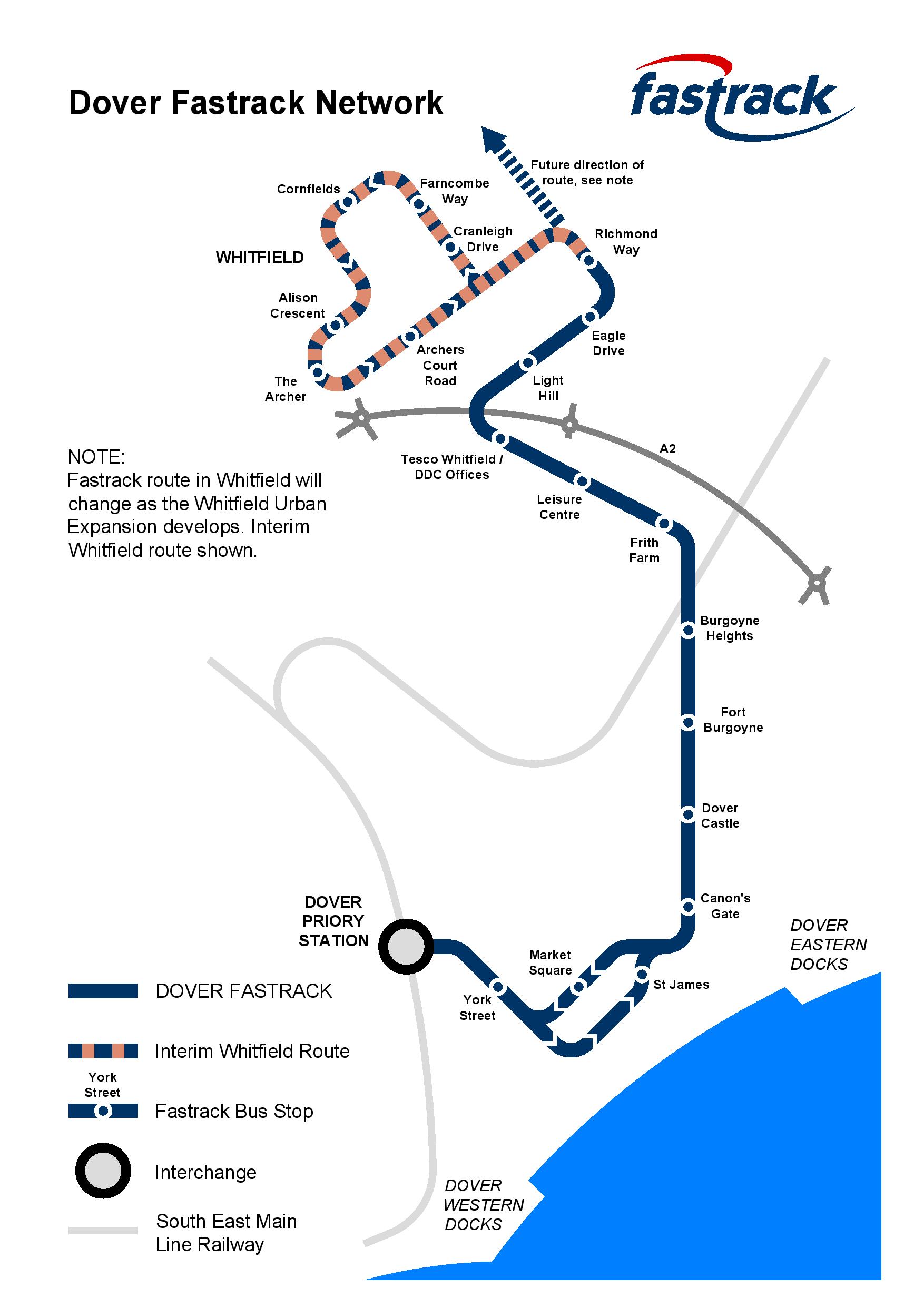Dover Fastrack

Dover Fastrack Service
The Dover Fastrack Bus Service started on the 17th November 2024. Initially the service will be operated by ultra low emission buses which will be replaced by a dedicated fleet of five electric buses in 2025.
Read the Latest news and service updates from Kent County Council
Bus Service Timetable - November 2024
Dover Fastrack Frequently asked Questions
Dover Fastrack Letter to Residents
Kent County Council Statement on Fastrack 08.11.24
Finishing works are underway on the Fastrack route, meanwhile Kent County Council announce a start date for the bus service of the 17th November 2024. Read more here - Dover Fastrack to launch in November
Read the latest from Kent County Council in their press release about the delivery of the Dover Fastrack Service - 9th April 2024.
Project team
Project manager: Kent County Council (KCC) Highways
Main contractor: Colas UK Projects Ltd
Public liaison officer: doverfastrackproject@colas.co.uk (for public enquiries about construction)
Funders: Homes England (Up to £22.9m of Housing Infrastructure Funding), Department for Transport (£9.5m Zero Emission Bus Regional Areas (ZEBRA) scheme), Dover District Council (£1.42m)
A real alternative to the car for local journeys
Dover Fastrack will be an all-electric rapid bus transit system connecting Whitfield with Dover town centre and Dover Priory railway station. Construction starts in February 2022 and is due for completion early in 2024. The main contractor for the project is Colas UK.
Fastrack buses will have priority on the proposed express route which will include a new bus, cycle and pedestrian-only bridge across the A2 at Whitfield, and a new link road from the B&Q roundabout in Whitfield to Dover Road at Guston. The junction with Dover Road will be for buses, bicycles and pedestrians only.
A fleet of new electric buses will operate on Dover Fastrack from 2025 as part of the Department for Transport’s Zero Emission Bus Regional Areas (ZEBRA) scheme.
Fastrack will provide a reliable, high-quality bus service. The frequency of the service will increase in line with the managed expansion of Whitfield.
Connections with HS1 services at Dover Priory
Dover Fastrack will also be integrated with Southeastern train services. The timetable will make it easy to access High Speed train services from Dover Priory railway station, ideal for commuting, leisure and business trips to and from London. It will also provide a quick and easy way to reach the town centre and Dover Castle.
It will be good for the environment too, helping the Council to meet its ambition to see the district become carbon neutral by 2050. Dover Fastrack will provide a real alternative to the car for local journeys.
Dover Fastrack is backed by central government with £16.1m from a funding programme designed to help stimulate new housing development. DDC was awarded the grant by Homes England and is working in partnership with Kent County Council as the Highways Authority.
Highways England have also been involved in the development of the proposed Fastrack route.
Dover is the county's second Fastrack service, building on the success of the Kent Thameside service in Dartford and Gravesham.
Better connecting a growing community
Dover Fastrack is a key part of the managed expansion of Whitfield as a place to live and work.
Dover Fastrack supports the sustainable development of new housing in Whitfield and at the former Connaught Barracks site, along with commercial development on the White Cliffs Business Park in Whitfield.
The Whitfield Urban Expansion was established in principal in the Council’s Core Strategy adopted in 2010, along with the redevelopment of the former Connaught Barracks site in Dover.
We are currently reviewing the Local Plan for the next twenty years to 2040. This will confirm our ongoing commitment to developing new homes, infrastructure and employment space in Whitfield.
Construction is also underway on 60 new homes on the former Officer’s Mess site at Connaught Barracks.
Up to 300 new homes are also planned on the main Connaught Barracks site. This site is owned by Homes England, the government’s housing accelerator.
The new infrastructure will connect new housing in Whitfield with the recently constructed Dover District Leisure Centre. The wider route will pass through Market Square in the town centre, which is due to be redesigned soon.
Your questions answered
Why are you building Dover Fastrack?
To connect new homes at Whitfield and Connaught Barracks with Dover town centre and Dover Priory railway station. It’s designed to encourage more people to use public transport for local journeys and to cut carbon emissions.
How will it cut carbon emissions?
By taking cars off the road for local journeys and using a fleet of electric buses. In England, around 68% of trips under five miles are made by car. Short car journeys disproportionately contribute to carbon emissions and air pollution.
Why don’t you just make it easier for electric cars with more charging points?
The Council has installed 40 electric vehicle charging points at 18 locations across the district. This is in addition to commercial providers. We’re also encouraging developers to include EV charging points in all new homes.
Why is a new bus service necessary?
Up to 6,000 new homes could be built at Whitfield requiring an enhanced bus service. There is also outline planning permission for up to 300 new homes on the site of the former Connaught Barracks which will also be served by Fastrack.
How many houses have been built in Whitfield?
The build rate has been slow thus far although this is expected to accelerate in the coming years. Having bus infrastructure in place early will help and is already being marketed as a selling point by developers.
Do you have permission to build so many houses in Whitfield?
A masterplan for the expansion of Whitfield, including a Bus Rapid Transit (BRT) was adopted by the Council in 2011. Land around Whitfield is allocated for development by the local plan and separate planning applications are brought forward with each phase of the development.
Why can’t you just upgrade the existing bus services from Whitfield to Dover?
Dover Fastrack will provide a much-improved service between Whitfield and Dover. The new bridge across the A2 avoiding the Whitfield roundabout, along with a new stretch of road near Guston, provides a faster and more reliable route into the town.
Who will use Dover Fastrack?
Dover Fastrack will be used by residents travelling to and from Whitfield and Dover. This could be for commuting to work, travel to school, visiting the town centre, shopping, and trips to the Dover District Leisure Centre. There will also be a stop at Dover Castle.
Will the service be commercially viable?
Research was undertaken on the viability of introducing a Bus Rapid Transit (BRT) system as part of the master planning for the expansion of Whitfield. There are ample reasons for travel to and from Whitfield and Dover. We expect usage to steadily rise with the expansion of Whitfield and as increased environmental awareness encourages more people to use public transport to cut their emissions. The Fastrack model has been shown to work in Dartford.
Will the bus stop at Dover Priory?
Yes. Dover Fastrack will connect with the high-speed and other train services from Dover Priory. It will be ideal for commuting to and from London, and for leisure trips.
Will Dover Fastrack operate late at night?
The service specification is still to be decided by Kent County Council in conjunction with the operator.
Who will operate Dover Fastrack?
The Fastrack brand is run by Kent Council County. Their intention is to work in partnership with Stagecoach as Fastrack will be an enhancement of their existing 61 route.
How much will it cost and how frequently will buses operate?
Fares and timetables will be announced once the operator has been confirmed.
Why can’t you repair existing roads rather than build Dover Fastrack?
Dover Fastrack is funded by central government from a fund designed to provide new infrastructure to support house building. The money can’t be used for anything else. You can report problems on local roads to Kent County Council.
Why can’t the money be spent improving the Whitfield roundabout?
As above, the funding can only be used for providing new infrastructure supporting the delivery of new homes. We continue to press for the need for improvements to both the Whitfield and Duke of York's roundabouts with the Government and Naitonal Highways.
Can cars use the new bridge?
No. The bridge across the A2 is for buses only, along with cyclists and pedestrians. Kent County Council will be consulting on plans to introduce an automatic number plate recognition system (ANPR) to control access to the bridge and the bus-only section of the route from the B&Q roundabout to Guston.
Why are existing bus services being cut?
Most bus services in Kent are operated by private bus operators. KCC is cutting its subsidies that help fund services that are not commercially viable. DDC does not operate any bus services.
Why not spend the money to support the services under threat?
The funding we’ve received for Dover Fastrack from central government can only be used to fund infrastructure that supports the construction of new homes.
